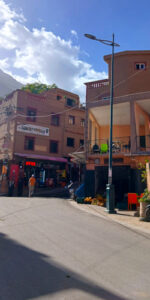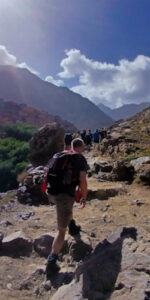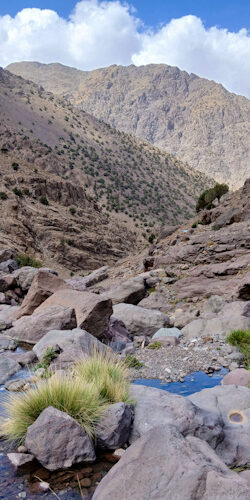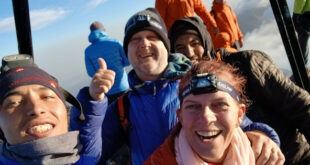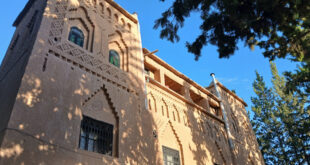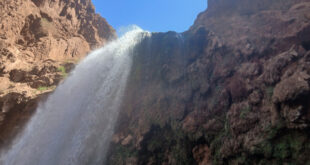I sink my poles into the damp earth between huge boulders and hoist myself up a giant step. Balancing precariously, I drunkenly weaving across the path. I feel dizzy, a sign of altitude sickness, and a scary reminder of the dangers of this challenge. In the inky depths of night we start our attempt to climb Mount Toubkal in 2 days. A brutal challenge that consists of steep inclines, scrambling over boulders glistening wet from earlier storms and exhausting my entire supplies of mental and physical resilience.
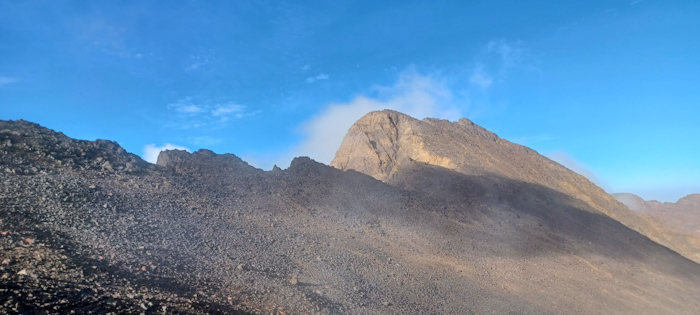
The summit attempt
As we exit the refuge at 4am, stars twinkle overhead, the only sounds the occasional squawking birds. The path rises vertiginously through a boulder field, a full body workout I had not anticipated. I pull, hoist, push and scramble over huge rocks, some hugging sheer drops. Thankfully, I am blissfully unaware as it is pitch black but for the eerie glow of our head torches flickering in the valley.
Lines of them stretch above us like fairy lights strung across the dark granite peaks that tower above us. The mountains are barren, a wasteland of boulders, rocks and pebbles that painfully pierce the soles of our feet as we zigzag up steep paths towards the summit.
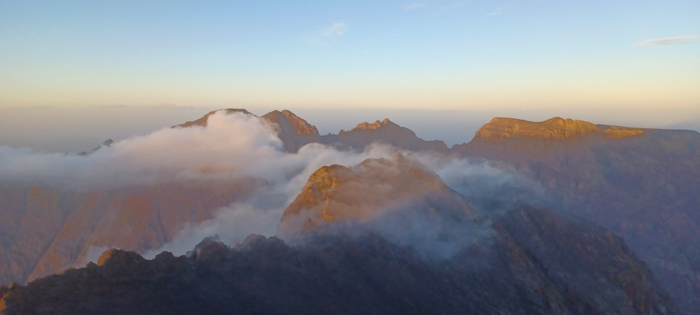
Mountain mind games
Progress is slow as a guide helps me clamber over slabs dotted with pools. I trail behind the group locked in an internal battle. ‘Just one more step’ I continually repeat to myself, a simple mantra to urge me upwards. My mind wants to sabotage my body as chirps negative thoughts that goad me to quit. The lethargy I feel in my legs is monstrous, as though they are clad in steel tights that weigh me down and make me doubt my capacity to reach the top.

Mostly I climb silently with Hamid, one of our guides, trailing behind. He offers an occasional elbow or helpfully suggests the best route whilst the demons in my head continue to argue. 1,000m to go becomes 600m and the exhaustion is immense. I stop to take on a Fuel bar and set off feeling revitalised only to feel sapped again within minutes. The cycle of walk, stop, breathe, silently telling the demons in my head to F off, continues. 600m becomes 400m and the raging mind war continues.
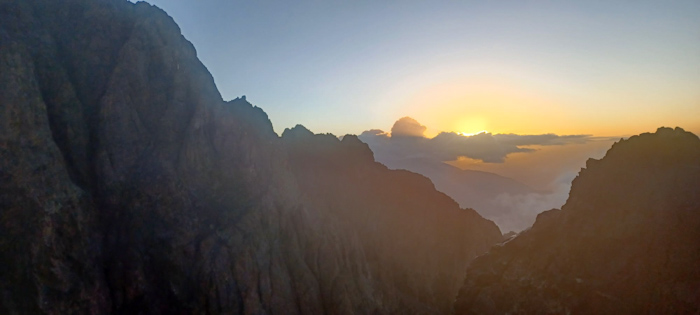
Sunrise on our Mount Toubkal climb
The rising sun offers a welcome respite and for the first time I feel a moment of joy. Light rises up sheer cliffside and a tinge of pink appears above. I start to feel energised as I realise I will lay the demons to rest but still each step is a momentous effort. We finally reach a plateau at around 4,000 metres and a magnificent view awaits.
Below, clouds shroud the valley and smaller peaks, whilst above the sun glows on the horizon casting shadows on the mountains. It is simply stunning. I nibble on some trail mix and with renewed vigour I continue upwards revelling in the majestic surroundings of the Atlas Mountains. A stunning tapestry of pink, red and orange hues paints the sky above and I catch my first glimpse of the top which still looks so high. Eventually I stumble onto a plateau, just a short gentle climb to the summit. The emotions threaten to overwhelm me as I realise the magnitude of the achievement. The personal challenge I have put to bed.
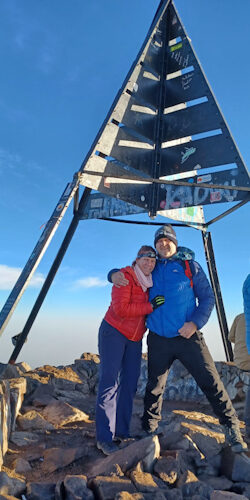
Celebrating our summit
Arm in arm with Jason, I stumble the last few steps and sob uncontrollably in his arms. Relieved and grateful to have tested my endurance and come out on top. The town of Imlil far below shimmers in the valley, barely awake at this hour. But up here, I am well and truly alive as I marvel at the incredible panoramic scenes stretching beneath.
Training to climb Mount Toubkal in 2 days
Undertaking a climb of Mount Toubkal in 2 days is not to be taken lightly. I readily confess, I did not give the mountain the respect it deserved, and it punished me for days afterwards. Admittedly 2024 has been plagued by health niggles and injury so I did what I could, but for this challenge aerobic fitness alone is not enough. You need to be both fit and strong, especially in your legs.
I am not a personal trainer, but your training should include some specific hill training with emphasis on the down as much as the up. The descent is what left me in agony for days afterward with my glutes, calves and abductors screaming blue murder.
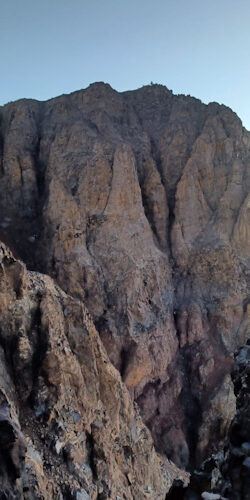
Possible training plans
Be under no illusions, regardless of how fit (or young) you are, the climb is absolute agony on the legs. Unless you already have very strong legs, I recommend significant time on a stairclimber, focused strength training and hiking with weighted backpacks.
To put this into perspective, in a normal week I run 3-4 times, cycle once or twice and workout with a PT twice. Although I have been injured I have been doing my usual PT and 3-4 cycles a week (mainly on the Watt Bike). I have a superior VO2 max (according to Garmin) but I still found this climb brutally hard. That said, the rest of our group were at least 15 years younger than Jason and I and the gap to the front group was rarely more than 20 minutes. Regardless of your age or fitness, this will not be a walk in the park.
If you need help to create a training plan, Ian Taylor offers some great tips on his mountaineering website that you can research.
Mount Toubkhal in 2 days
So what is the actual climb like?
The morning ascent
To climb Mount Toubkhal in 2 days, you have to ascend a whopping 1,500 metres in one day. The trek starts in Imlil and climbs steeply to a restaurant overlooking some falls where you will stop for lunch. This first stint takes between 2 and 3 hours and climbs 600 metres.
From the valley bottom it is hard going. Not surprisingly, it is a relentless upward grind and even the rare flat bits are torturous. The route often follows paths of stones and pebbles and even in solid hiking boots it is incredibly painful underfoot. The path in the photo above is one of the better trails we followed.
The afternoon ascent
After lunch, you continue for about another 1,000 metres of ascent to the overnight refuge. This takes between 3 and 4 hours and is a mixture of terrain including paths, rocky scrambles and more pebble strewn trekking routes. The first sight of the refuge is a huge relief as you realise you have conquered the majority of the climb.
It is not uncommon to be clambering over boulders like these, especially on the second day.
Summit ascent
On day 2, the final push to the summit is another 4 – 5 hours trek and a steep 1,000 metres ascent in the dark. It involves scrambling, climbing over boulders and trekking alongside sheer drop offs.
The descent
The descent however is the most torturing part of the trip. After a 2 – 3 hour descent from the summit back to the refuge, you will descend the remaining 1,500 metres to Imlil without a break.
So, your second day involves 1,000 metres of climb followed by 2,500 metres of descent. Those last hours of descent are soul destroying. You may suffer from cramp in your calves, your toes and soles will bruise and every muscle in your upper legs will scream in violent protest at the demands you place on them.
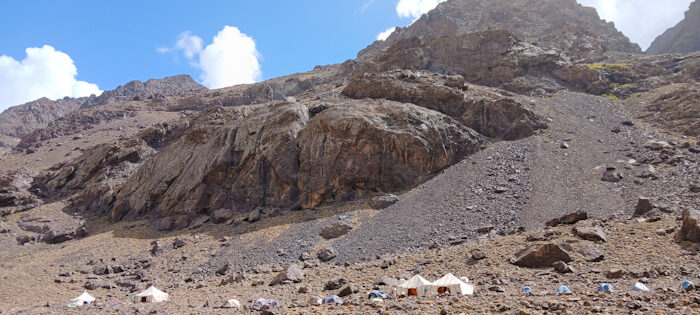
Kit
One thing you can do to make a climb of Mount Toubkhal in 2 days less painful is ensure you have good quality kit.
I will be writing a much more comprehensive blog on this in due course but for now, do ensure you read the information provided by the tour company. On both days of our climb, we had to trek through thunderstorms and torrential rain, only bearable because we had good kit.
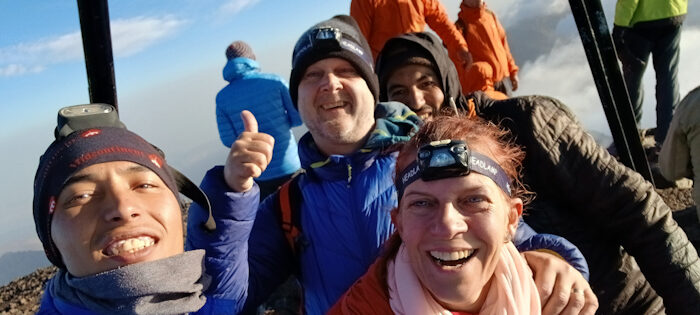
Accommodation
There are a number of mountain refuges all located on the same plain at around 3,100 metres. We stayed in Refuge Du Camping du Toubkhal Les Mouflons. Our group shared a room with 16 bunks wedged into a tiny space. There is little storage space so do not expect much in the way of comfort. I only found 2 toilets in the whole of the refuge and estimate there was well over 100 people staying overnight. Note also that toilet paper is like gold dust so do ensure that you bring your own.
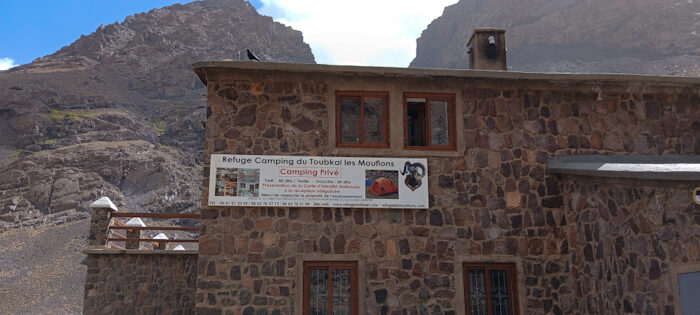
Food and drink
Your guides organise your food on the mountain. The trip includes lunch and dinner on day and breakfast and lunch on day two. Lunches are generally shared dishes of salads (laden with coriander as an FYI if you cannot stand this herb!), chicken or lamb stews and rice and pastas.
Breakfast is the usual type of food you will eat for breakfast in Morocco, namely boiled eggs, breads and jams.
On summit day you will eat around 3.30 and will not eat a cooked lunch again until around noon depending on your climb time. It is essential therefore to ensure you bring sufficient snacks to maintain your energy throughout the climb. Jason and I each consumed 2 energy bars on both days which felt about right. There is a also small tuck shop in the refuge which sells snacks and toilet paper if you prefer to buy them there.

Climate
We climbed at the end of September and experienced torrential downpours and thunderstorms both afternoons. Sheet lightning lit up the sky directly above us with crashing thunder echoing through the valley. Although a little scary, it added to the drama of the trip.
Other than on our approach to the summit which was in the dead of night, the temperature was quite benign. We only needed hats and gloves for a few hours on summit day.
Mount Toubkal is however the highest peak in North Africa and experiences a broad range of temperatures depending on the season. You should plan accordingly and accept it is better to bring items you do not need then not bring them and potentially compromise your ascent as a result.
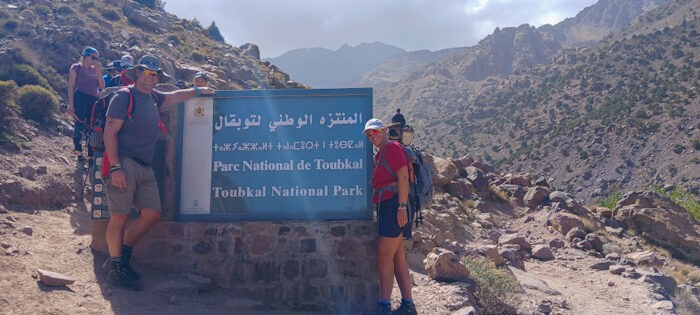
Temperatures
During the summer, daytime temperatures at the summit can reach between 10°C to 20°C. Even in summer though nights can be chilly, with temperatures often dropping to freezing.
As winter approaches, especially from November until April, temperatures can plummet significantly. Daytime highs may hover around freezing and night time temperatures drop well below that.
During these months, it is more likely that a water bladder might freeze, making water bottles a more practical option for carrying your hydration needs.
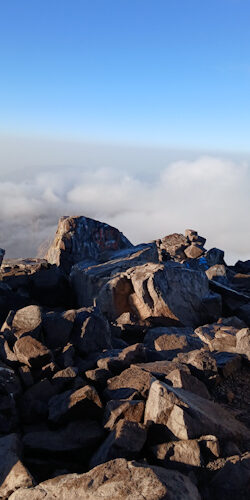
Altitude sickness
Warning. I am not a doctor so please take medical advice if you are unsure whether this is a suitable trip for you.
Altitude sickness manifests in many forms and effects everyone differently. At these altitudes you may suffer with headaches, dizziness, nausea, loss of appetite, inability to sleep and lethargy.
Normally the advice for optimum acclimatisation is to ascend no more than 500 metres a day and to sleep lower than your highest point. That goes out of the window when you climb Mount Toubkhal in 2 days.
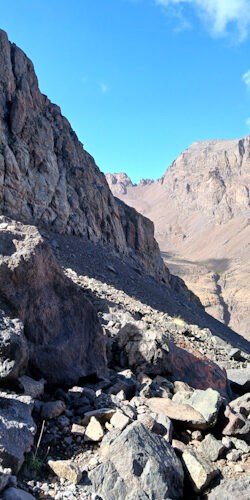
Ascent pace
You will climb 2,500 metres in just 2 days which is brutal. You should therefore anticipate that you may feel some of the above symptoms. Paracetamol can be helpful for the headaches (although note, it did not work for me on either this trip or our Everest Base Camp trip).
It’s hard to say whether this was due to the altitude or dehydration as it is hard to keep hydrated as you climb. There were people on our trip with just small water bottles which is simply not enough for a trek of this kind so do bring large refillable water bottles for your climb.
Why you should climb Mount Toubkal in 2 days
Despite the difficulty of this challenge, there are many positives to a 2 day climb of Mount Toubkhal. It does not eat into your holiday time too much which leaves you plenty of time to explore the other wonderful sights that Morocco has to offer.
The downside is that it is incredibly punishing on your body however this can be overcome with ample training beforehand.
We booked our tour through Get Your Guide. Take a look at the options below for both the 2 day ascent and other options.
 From Miles to Smiles Stylish travel for professionals seeking luxury at affordable prices
From Miles to Smiles Stylish travel for professionals seeking luxury at affordable prices
